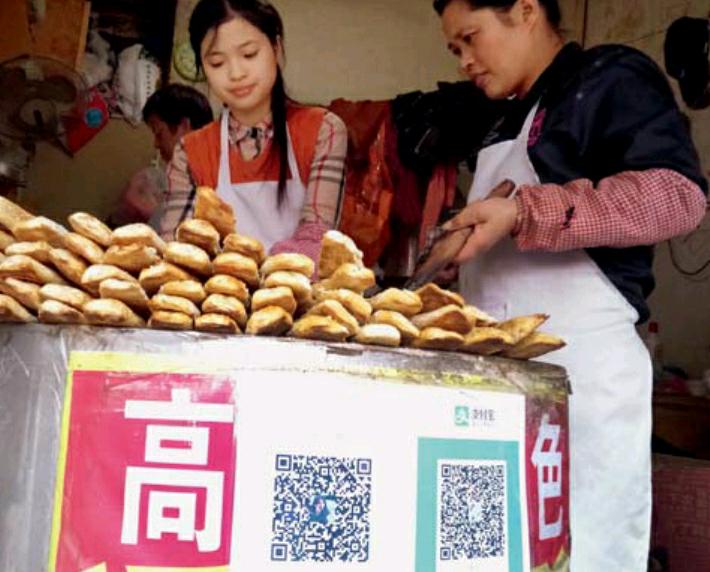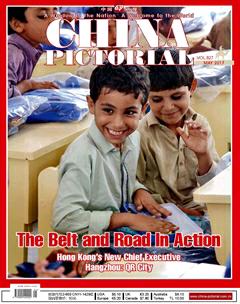Hangzhou:QR City
by+Ma+Weihui
Hangzhou, capital of the south- eastern Chinese province of Zhejiang, has newly become famous as a “mobile payment city” after a news report that sounded a little funny. On March 27, 2017, two robbers traveled to Hangzhou by plane and bus. After robbing three stores, they had stashed only two thousand yuan, less than the cost of the trip to Hangzhou. Many pointed out that residents of the city, which happens to host the headquarters of Alibaba, mostly pay with Alipay or WeChat. Cash is seldom used. QR codes for mobile payments can be seen everywhere from noodle restaurants to roast sweet potato stands. To say that mobile payments are popular in the lakeside city would be an understatement. Every stand at the Songmu FarmersMarket features a sign reading “Payment by Alipay Recommended” over a QR code. A QR code is pasted over a Chinese oven rolls shop near Zhejiang University in the city. Most customers pay by scanning the QR code with their smartphones. Next to the code is a small basin for cash, with just a few coins.
According to data from Ant Financial, citizens of Hangzhou can use smartphone apps to pay for 98 percent of taxis, at 95 percent of supermarkets and in over 50 percent of restaurants. Research conducted by the National School of Development of Peking University ranked Hangzhou first in inclusive finance from 2011 to 2015 among 337 Chinese cities. It tops Chinese cities in mobile payment proliferation, credit investigation, financial management, investment and insurance. Hangzhou has already be- come one of the most mobile paying cities in the world.
Smart Healthcare
If you open the Alipay app and click“Smart Healthcare,” youll see the list of hospitals in Hangzhou. You can make an appointment, check the results of a physical examination, pay the clinic fee, and do many other things with your phone.
“In the past, many people waited all day and night to see a doctor,” admits Cai Xiujun, president of Sir Run Run Shaw Hospital. “Now, they can just rest and use their phones to set up appointments. The app will inform them of when and where they can see a doctor, get an ultrasound and buy medicine. They no longer have to rush to the hospital extremely early in the morning.”
Cai notes that the outpatient clinic sees about 8,000 visitors daily and is perpetually crowded with patients. To help alleviate the stress of heavy demand, Sir Run Run Shaw Hospital designed Chinas first smart online hospital platform.
Now, almost every non-medical procedure at the hospital can be performed online. Patients can make appointments, receive notices while waiting at the hospital, pay bills, check test results and receive guidance. Patients can even rate the doctors like purchases on Taobao (known as Chinas Amazon).
“Patients now spend an average of 1.7 hours in our hospital, much shorter than the former 4 to 5 hours,” adds Cai.
Paying Tolls with QR
Recently, drivers on the ShanghaiHangzhou-Ningbo Expressway have discovered a third option instead of cash or the Electronic Toll Collection (ETC) system: They can scan a QR code with their phones. The expressway introduced Alipay to its exits during the National Day holiday in 2016.
Guo Chaoqun, manager of the Operations Department of the expressway, reveals that the new payment method was introduced due to customer demand—so many customers in Hangzhou are already so accustomed to mobile payment that they dont carry cash. Any driver not carrying enough cash must make some sort of pledge. So many asked to pay with Alipay that the expressway took the initiative to seek cooperation with the payment platform.
“At first, Alipay was only used for emergency situations, but staff found it very convenient and we saw increasing numbers of drivers opting to pay in this way,” he continues. “Now, about 5,000 tolls are paid with mobile payments every day, totaling about 200,000 yuan, around 2 percent of our total.”
Scanning QR codes has also accelerated payment speed. In the past, the average time for a vehicle to finish the payment process was 13 seconds. Trucks, which usually pay more, typically require more time. However, the amount of the payment doesnt affect the speed of scanning a QR code, which takes less than 10 seconds on average.
Efficient Administration
In January, Che Jun, governor of Zhejiang Province, promised accelerated reform and streamlined administration. His aim was to cut the time taken and slash formalities for individuals or representatives from enterprises dealing with governmental departments.
For instance, individuals in need of value-added tax invoices formerly had to go to the tax authority to apply. Last December, Zhejiang launched a trial run of issuing value-added tax invoices online, and individual taxpayers can even download them.
“People no longer have to visit the tax authority to get the invoice,” beams Cui Chengzhang, deputy director of the Zhejiang Provincial Office of the State Admin- istration of Taxation (SAT). “The online platform has been tremendously popular with taxpayers. We want to expand this service across the province.”
Zhejiang now operates both an online civil affairs administration platform and an online public payment platform, both the first in China, making Zhejiang the leading province for the “Internet+Government Service”by enabling people to make payments and receive governmental services from home.
Emergence of QR City
Outsiders have long regarded Hangzhou as a city with beautiful scenery and a well-developed private economy. Its inclusive finance has provided new lift for Hangzhou, making it one of the most economically dynamic cities in China. In 2016, the tertiary industry accounted for 61.2 percent of Hangzhous GDP, of which information technology contributed over 50 percent, with an increase of 268.8 bil- lion yuan.
Hangzhou is among the Chinese cities to witness the fastest development of mobile payments. Mobile payments are now widely used in large and medium-sized cities throughout China and are also reaching smaller cities and villages. In the foreseeable future, China may become a cashless society. Mobile payments have not only brought convenience to daily life but have also become a new economic growth point.

